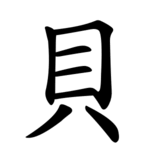| 貝 | ||
|---|---|---|
| ||
| 貝 (U+8C9D) "shell" | ||
| Pronunciations | ||
| Pinyin: | bèi | |
| Bopomofo: | ㄅㄟˋ | |
| Wade–Giles: | pei4 | |
| Cantonese Yale: | bui3 | |
| Jyutping: | bui3 | |
| Japanese Kana: | ハイ hai / バイ bai (on'yomi) かい kai (kun'yomi) | |
| Sino-Korean: | 패 pae | |
| Names | ||
| Chinese name(s): | (Side) 貝字旁/贝字旁 bèizìpáng (Bottom) 貝字底/贝字底 bèizìdǐ | |
| Japanese name(s): | 貝/かい kai 貝偏/かいへん kaihen 小貝/こがい kogai (as opposed to 大貝/おおがい ōgai standing for 頁) | |
| Hangul: | 조개 jogae | |
| Stroke order animation | ||
 | ||
Radical 154 or radical shell (貝部) meaning "shell" is one of the 20 Kangxi radicals (214 radicals in total) composed of 7 strokes.
In the Kangxi Dictionary, there are 277 characters (out of 49,030) to be found under this radical.
贝, The simplified form of 貝, is the 76 indexing component in the Table of Indexing Chinese Character Components predominantly adopted by Simplified Chinese dictionaries published in mainland China, while the traditional form 貝 is listed as its associated indexing component.
YouTube Encyclopedic
-
1/3Views:196 7202 84284 681
-
How 4chan Turned The Internet Right Wing (And Why That Might Change)
-
Revolutionary Feminisms: Virtual Book Launch
-
Rasta Professor Talks Reparations, the Bl*ck Man's Bible, POT, Socialism, and More! (#156)
Transcription
Evolution
-
Oracle bone script character
-
Bronze script character
-
Large seal script character
-
Small seal script character
Derived characters
| Strokes | Characters (貝) | Characters (贝) |
|---|---|---|
| +0 | 貝 | 贝SC (=貝) |
| +2 | 貞 貟 負 | 贞SC (=貞) 负SC (=負) 贠SC (=貟) |
| +3 | 財 貢 貣 貤 | 贡SC (=貢) 财SC (=財) |
| +4 | 貥 貦 (=玩 -> 玉) 貧 貨 販 貪 貫 責 貭 (=質) 貮 (=貳) | 责SC (=責) 贤SC (=賢) 败SC (=敗 -> 攴) 账SC (=賬) 货SC (=貨) 质SC (=質) 贩SC (=販) 贪SC (=貪) 贫SC (=貧) 贬SC (=貶) 购SC (=購) 贮SC (=貯) 贯SC (=貫) |
| +5 | 貯 貰 貱 貲 貳 貴 貵 貶 買 貸 貹 貺 費 貼 貽 貾 貿 賀 賁 | 贰SC (=貳) 贱SC (=賤) 贲SC (=賁) 贳SC (=貰) 贴SC (=貼) 贵SC (=貴) 贶SC (=貺) 贷SC (=貸) 贸SC (=貿) 费SC (=費) 贺SC (=賀) 贻SC (=貽) |
| +6 | 賂 賃 賄 賅 賆 資 賈 賉 (=恤 -> 心) 賊 賋 賌 賍 (=贓) 賎JP (=賤) | 贼SC (=賊) 贽SC (=贄) 贾SC (=賈) 贿SC (=賄) 赀SC (=貲) 赁SC (=賃) 赂SC (=賂) 赃SC (=贓) 资SC (=資) 赅SC (=賅) 赆SC (=贐) |
| +7 | 賏 賐 賑 賒 賓 賔 (=賓) 賕 賖 賗 賘 (=贓) | 赇SC (=賕) 赈SC (=賑) 赉SC (=賚) 赊SC (=賒) |
| +8 | 賙 賚 賛 (=贊) 賜 賝 賞 賟 賠 賡 賢 賣 賤 賥 賦 賧 賨 賩 質 賫 (=齎 -> 齊) 賬 | 赋SC (=賦) 赌SC (=賭) 赍SC (=賫=齎 -> 齊) 赎SC (=贖) 赏SC (=賞) 赐SC (=賜) 赑SC (=贔) 赒SC (=賙) 赓SC (=賡) 赔SC (=賠) 赕SC (=賧) |
| +9 | 賭 賮 (=贐) 賯 賰 賱 賲 賳 賴 賵 | 赖SC (=賴) 赗SC (=賵) |
| +10 | 賶 賷 (=齎 -> 齊) 賸 (=剩 -> 刀) 賹 賺 賻 購 賽 | 赘SC (=贅) 赙SC (=賻) 赚SC (=賺) 赛SC (=賽) |
| +11 | 賾 賿 贀 贂 贃 贄 贅 | 赜SC (=賾) |
| +12 | 贆 贇 贈 贉 贊 贋 (=贗) 贌 | 赝SC (=贗) 赞SC (=贊) 赟SC (=贇) 赠SC (=贈) |
| +13 | 贍 贎 贏 | 赡SC (=贍) 赢SC (=贏) |
| +14 | 贐 贑 (=贛) 贒 (=賢) 贓 贔 | |
| +15 | 贕 贖 贗 贘 (=賞) | |
| +16 | 贙 贚 | |
| +17 | 贛 | 赣SC (=贛) |
| +18 | 贜 (=贓) |
Sinogram
The radical is also used as an independent Chinese character. It is one of the Kyōiku kanji or Kanji taught in elementary school in Japan.[1] It is a first grade kanji[1]
References
- ^ a b "The Kyoiku Kanji (教育漢字) - Kanshudo". www.kanshudo.com. Archived from the original on March 24, 2022. Retrieved 2023-05-06.
Literature
- Fazzioli, Edoardo (1987). Chinese calligraphy : from pictograph to ideogram : the history of 214 essential Chinese/Japanese characters. calligraphy by Rebecca Hon Ko. New York: Abbeville Press. ISBN 0-89659-774-1.




